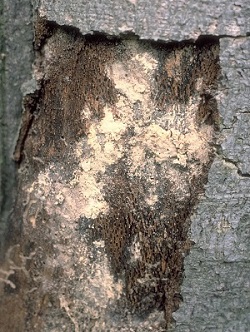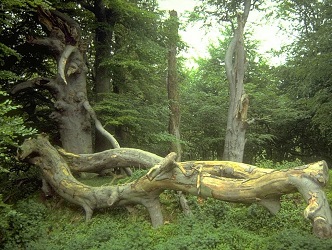Current ISIS code: A212
Previous assemblage name: A222 bark & sapwood decay including conifers
Linked assemblage: A213 fungal fruiting bodies, A211 Heartwood decay.
Description of habitat typically supporting the assemblage: This assemblage type is mainly characterised by beetles.
The assemblage type is found in and around trees and shrubs generally, but especially in older specimens. The assemblage is primarily associated with death and decay of the outer woody tissues of the trees or shrubs - the sapwood and bark.

Some species are associated with fluxes of sap (sap-runs). The composition of the assemblage varies with tree species far more than the heartwood assemblage does, since the tissue structure and chemical composition is more species-related. The assemblage is also less affected by the density of tree cover than the heartwood assemblage, although there is a suite of species that is restricted to the larger lower canopy boughs of open-grown trees. Other species are said to develop in dead boughs high in the canopy.
This assemblage is particularly found in dead limbs that are either still attached to living trees or recently fallen.

In smaller branches, this assemblage starts to be replaced by a more generalist late-successional assemblage within a year of hitting the ground, although it may persist for several years in larger limbs and stumps. As with the heartwood assemblage, sites with the fullest expression of the assemblage are historic sites with concentrations of mature and older trees, and so ancient wood pasture - and ancient woodland situations generally - are the most important.
The juxtaposition of mature and aging trees with open areas containing flowering shrubs is a key factor since the adult stages of many of the included insects have a requirement for pollen and nectar.
Potentially important environmental impacts
- Lopping of dead limbs.
- Removal of fallen wood.
- Cutting up and stacking of wood (damaging to species which require larger amounts of habitat).
- Removal of trees with sap fluxes for ‘forest hygiene’ reasons.
Sampling & assessing the assemblage
Standard sampling protocols apply; passive traps run over defined times can provide ISIS-compliant data sets.
Target groups: Principally beetles & flies
Fieldwork methods: Tubing/direct pooting; direct searching, beating
Alternative methods: Vane traps
Season: Spring-Summer-Autumn
Typically, 3 visits should be made to coincide with the hawthorn flowering period (April-May), the bramble period (July-August), and the fungal period (September-October). The 3 deadwood assemblages are frequently worked as one. The IEC/RIEC report technically only operates over a sustained and species-cumulative period of trapping, but remains useful in assessing an annual survey dataset and seeing how that compares.
